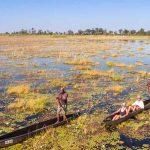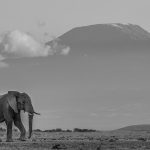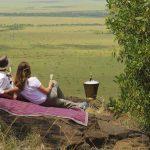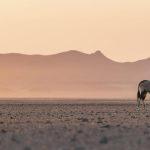Brian Jackman watches the Serengeti wildebeest migration – or ‘the greatest show on earth’ – in comfort that not even Hemingway would have enjoyed.
Snug in my tent in the northern Serengeti, I listened to the strange, pulsing cries of a swamp nightjar in the surrounding trees. Later, when the nightjar had fallen silent and dawn seeped through the canvas, a lion began to roar not far off. I dressed hurriedly, stepped outside and eventually picked him out with my binoculars, sprawling at full length on a granite kopje, gold mane on fire in the morning sun. What a way to start the day.
In 1913, an American big-game hunter called Stewart Edward White set out from Nairobi and headed south. “We walked for miles over burned-out country,” he wrote. “Then I saw the green trees of the river, walked two miles more and found myself in paradise.”
What he described is what we now call the Serengeti, a Masai word meaning “the land that goes on for ever”, where, every year, drawn by the presence of some 3,000 lions and above all by the spectacle of the wildebeest migration – the greatest wildlife show on earth – more than 90,000 visitors flock to what has become the world’s most famous national park.
Yet distances are so vast that it is still possible to find space and solitude, especially in the northernmost reaches of the park, whose horizons are empty of everything except wildlife. This is Tanzania’s Top End, where nothing but a line of white stones in the grass separates the Serengeti from Kenya’s Masai Mara national reserve – a border the migrating herds cross with impunity every year.
Not so long ago this was bandit country, crawling with poachers and cut off from the rest of the park by thorny woodlands infested with tsetse flies. Now the poachers are on the back foot. The park rangers are firmly in control and tourism is taking root on these remote savannahs of the wild northwest.
Among the safari specialists who have moved in is &Beyond, a Johannesburg-based company whose upmarket portfolio of camps and lodges is matched by a long-standing commitment to conservation. In 2006 it came up with the idea of Serengeti Under Canvas, a seasonal camp with the lightest of footprints that would move to different locations during the year so that guests would never be more than an hour’s drive from the migration. Its newest site is a dappled grove with far-reaching views into Kenya, and if you go there in late October – as I did – you will find yourself in the thick of the action.
Not even Hemingway in his heyday enjoyed such comforts as those provided by its nine spacious walk-in tents, each one a khaki cave of comfort with en-suite loos, hot bucket showers, and polished brass bowls for washing and shaving. Persian rugs complete the picture and nothing is left to chance. There are even brollies for wet days and hot-water bottles for chilly nights. Five-star camping this may be, but it is offered with an elegant simplicity that sits easily in the pristine surroundings.
Around the camp lies a sea of bush, a neglected orchard of small, crooked trees lit up by the dazzle of galloping zebras. Through the leafy canopy loom granite whalebacks – including the one where I saw the lion – leading to a wild, broken country of rocky ridges and grassy valleys in which steep-sided korongos – seasonal watercourses – wind down to the Bologonja River.
In November the camp moves south, following the herds to a new location in the Seronera Valley; and in January it moves again to be on the spot for the season of birth on the short grass plains between Lake Ndutu and the Gol Mountains. But it is here in this far northwest corner of the park that the big river crossings take place, and if you don’t want to miss this extraordinary spectacle, then Serengeti Under Canvas is the place to be.
For days, delayed by the onset of the rains, the wildebeest had been massing in the Lamai Wedge, a triangle of pristine grasslands between the Kenyan border and the Mara River. Now, driven by the urge to return to their calving grounds, they were unstoppable. Regardless of the waiting crocodiles they poured across the fast-flowing river, like an army in full retreat.
With me was Les Carlisle, &Beyond’s group conservation manager, who had flown up from Johannesburg to join me. He has spent his whole working life in the bush, yet even he was rendered almost speechless by the drama unfolding around our Land Cruiser. “Unbelievable,” he muttered as we watched them plunging headlong into the water. An hour later they were still storming across in wave after wave of tossing heads, eyes rolling in panic until they stumbled clear of the water and thundered past us on either side.
We witnessed only one casualty, a yearling wildebeest dragged under by a monster croc, and even while the crossing was at its height the other river creatures – hippos, storks and malachite kingfishers – got on with their lives as if nothing was happening. Nearby lay a lioness fast asleep in a thicket, her belly distended by an earlier meal; and at one point an Egyptian goose with a dozen fluffy goslings paddled right through the midst of the struggling herds.
For the next few days the wildebeest were all around camp, filling the air with their sonorous groans as they swarmed among the trees, coalescing like molasses on the open hillsides before streaming away in unbroken columns that stretched for miles.
For the Serengeti predators the arrival of the migration signals a time of plenty. Every night echoed to the hacksaw cough of prowling leopards, and every morning we went looking for lions among the Wogakuria Kopjes, an African Dartmoor of granite outcrops that pierce the infinity of plain and sky. You couldn’t design a better big-cat habitat than this tumbledown chaos of cottage-size boulders, and most days the lions obliged, posing against the blue on a granite dome or else staring sphinx-like into the distance where Mlima Saba – the Seven Hills – mark the beginning of the Masai Mara. No wonder Myles Turner, the renowned Serengeti warden of the 1960s, loved this area above all others.
Lions are not the only creatures to seek the shelter of the kopjes. Agile klipspringers – small antelopes that stand on tiptoe, like ballet dancers – keep watch from these enigmatic rock castles. Leopards give birth in hidden caves, and fig trees rooted among the crevices provide fruit for green pigeons and deep shade for eagle owls.
The area I loved best, though, lay across the Bologonja River, where immense plains rolled away to the Nyamalumbwa Hills. This was new country for me – the final piece of the Serengeti jigsaw and every bit as uplifting as the more familiar grasslands in the south of the park. Apart from the desert dates whose parasol shapes graced every skyline, the plains were virtually treeless. Jackals rose out of the land and trotted away at our approach. Eland ran along the horizon and the clear highland air was filled with the guttural cries of sandgrouse.
Late-afternoon storms had replenished the landscape, greening the hillsides where drifts of white taka-taka flowers now blossomed among the scattered bones of old kills – a perfect metaphor for the Serengeti, where life and death go hand in hand.
In this infinity of grass and cloud shadows we drove all day and never saw another soul. We searched for cheetahs but instead, far out in the all-embracing loneliness of the plains, we came upon a pair of mating lions, lying as if half-drugged by the heat and oblivious to the European swallows hawking for insects about their ears.
Back in camp at end of day, I arrived to find that sundowners had been arranged on a nearby kopje. Red Masai blankets had been laid out on the flat rocks, and there I sat in the deepening amber light, cold beer in hand, looking out over what felt like the whole of Africa as thunder rumbled in the hills and curtains of rain trailed over the expanse.
Wildebeest migration basics
Brian Jackman travelled with Africa Odyssey (020 7471 8780; https://www.africaodyssey.com). The company can arrange a week’s safari based on three nights at Serengeti Under Canvas and three nights at &Beyond’s Grumeti River Camp in the Western Corridor from £4,975 per person, including return BA economy flight from London, all local flights and one night in Nairobi at the Palacina Hotel.
A new edition of Brian Jackman’s wildlife classic The Marsh Lions: the Story of an African Pride has been published by Bradt Travel Guides. It is available from Telegraph Books (0844 871 1515; books.telegraph.co.uk) at £9.99 plus 99p p&p.
The best places to see the Serengeti wildebeest
For the Serengeti wildebeest every year is an endless journey, chasing the rains in a race for life. The action takes place across 154,000 square miles of woodlands, hills and open plains, a wilderness bigger than Holland including not only the Serengeti national park and Kenya’s Maasai Mara national reserve but also the dispersal areas beyond.
The key players in this 1,200-mile odyssey are the wildebeest – all 1.3 million of them – but they are joined on their journey by 200,000 zebras, 350,000 gazelles and12,000 elands.
The yearly cycle begins in the south of the park when half a million calves are born between January and March – most in a three-week period. Up and running almost from the moment they hit the ground, they grow fast on the rich volcanic soils of the short-grass plain. But when the long rains of April and May are over the plains dry out and the grazers must move on.
Herds tend to follow the rainfall gradient, which increases from south-east to north-west. On leaving the calving grounds at the end of May, some head north into the Seronera Valley, but most push on into the Western Corridor, where they must play Russian roulette with monster crocodiles as they cross the Grumeti River.
June is the rutting season, which takes place as the wildebeest swarm through the park’s northern woodlands en route to their dry season refuge in the Maasai Mara.
Zebras are often the first to arrive in the Mara, chomping down the tall red oat grass with the wildebeest hot on their heels. Here they remain from July to October, sweeping this way and that across the reserve in search of fresh grazing. If you want to see them storming across the Mara River, this is the time to come.
With the beginning of the short rains in late October or early November the migration makes its way back into the Serengeti, making this a good time to be anywhere in the north of the park between Klein’s Camp and the Lamai Wedge. By December, having emerged from the northern woodlands, the herds pour across the Seronera Valley to mass on their calving grounds again and the circle is complete.





